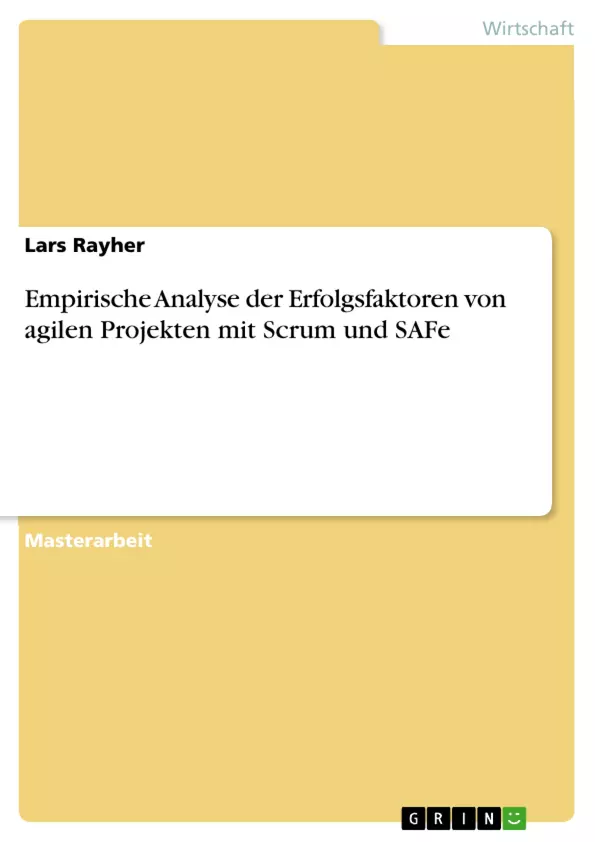Die Thesis untersucht die Bedeutung von Agilität in Unternehmen, insbesondere in Zeiten zunehmender Komplexität und Digitalisierung. Dabei liegt der Fokus auf den agilen Projektmanagement-Methoden Scrum und Scaled Agile Framework (SAFe). Durch die Analyse dieser Frameworks soll herausgefunden werden, welche Faktoren den Erfolg von Projekten fördern. Die Arbeit basiert auf praktischen Erfahrungen des Autors als Agile Consultant und zielt darauf ab, Empfehlungen für die erfolgreiche Umsetzung agiler Methoden in der Praxis abzuleiten.
Inhaltsverzeichnis
- Einleitung
- Motivation und Zielsetzung
- Vorgehen und Methodik
- Forschungsfragen
- Theoretische Grundlagen
- Grundlagen Projektmanagement
- Klassisches Projektmanagement
- Agiles Projektmanagement
- Scrum: Überblick und Geschichte
- Scrum Framework
- Scrum-Team
- Scrum-Events
- Scrum-Artefakte
- Grundlagen skalierter Frameworks
- SAFe Scaled Agile Framework
- Essential SAFe
- Large Solution SAFe
- Portfolio SAFe
- Full SAFe
- Aktueller Forschungsstand
- Erfolg in klassischen Projekten
- Bedeutung Erfolg in klassischen Projekten
- Erfolgskriterien in klassischen Projekten
- Erfolg in agilen Projekten
- Bedeutung Erfolg in agilen Projekten
- Erfolgskriterien in agilen Projekten
- Erfolgskriterien von Scrum-Methoden
- Erfolgskriterien von skalierten Methoden
- Erkenntnisse aus der Literatur
- Methodisches Vorgehen
- Forschungsdesign
- Experteninterview
- Qualitative Forschung
- Teilstrukturiertes Experteninterview
- Konstruktion des Interviewleitfadens
- Interviewpartner und Interviewdurchführung
- Qualitative Inhaltsanalyse nach Mayring
- Fragebogen
- Quantitative Forschung
- Erhebungsmethode Online-Fragebogen
- Konstruktion des Fragebogens
- Durchführung des Fragebogens
- Auswertungsmethode
- Ergebnisse
- Qualitative Analyse des Interviews
- Experteninterview – Erfolgskriterien Scrum-Projekte
- Experteninterview – Erfolgskriterien SAFe-Projekte
- Zusammenfassung und Einfluss auf den Fragebogen
- Darstellung der Ergebnisse des Fragebogens
- Soziodemografische Merkmale
- Deskriptive Statistik der Kategorie Menschen
- Deskriptive Statistik der Kategorie Organisation
- Deskriptive Statistik der Kategorie Technologie
- Deskriptive Statistik der Kategorie Prozesse
- Deskriptive Statistik der Kategorie Projekt
- Korrelationsanalyse
- Explorative Faktorenanalyse
- Gütekriterien
- Objektivität
- Reliabilität
- Validität
- Interpretation und Diskussion
- Implikationen
- Limitationen
Zielsetzung und Themenschwerpunkte
Diese Masterarbeit untersucht empirisch die Erfolgsfaktoren agiler Projekte, die mit Scrum und SAFe umgesetzt werden. Ziel ist es, ein umfassendes Verständnis der Erfolgsfaktoren in beiden Frameworks zu entwickeln und praktische Handlungsempfehlungen für die Projektpraxis abzuleiten.
- Erfolgsfaktoren agiler Projekte mit Scrum
- Erfolgsfaktoren agiler Projekte mit SAFe
- Vergleich der Erfolgsfaktoren zwischen Scrum und SAFe
- Einflussfaktoren auf den Projekterfolg (Mensch, Organisation, Technologie, Prozesse)
- Ableitung von Handlungsempfehlungen für die Praxis
Zusammenfassung der Kapitel
Die Einleitung führt in die Thematik ein und definiert die Forschungsfragen und Methodik. Der zweite Teil beleuchtet die theoretischen Grundlagen des klassischen und agilen Projektmanagements, Scrum und SAFe. Kapitel drei präsentiert den aktuellen Forschungsstand zu Erfolgskriterien in klassischen und agilen Projekten. Das methodische Vorgehen in Kapitel vier beschreibt die qualitative und quantitative Erhebungsmethode (Experteninterviews und Fragebogen). Kapitel fünf präsentiert die Ergebnisse der Datenanalyse.
Schlüsselwörter
Agiles Projektmanagement, Scrum, SAFe, Erfolgsfaktoren, empirische Forschung, qualitative Forschung, quantitative Forschung, Experteninterviews, Fragebogen, Projektmanagement, Skalierung, Handlungsempfehlungen.
- Quote paper
- Lars Rayher (Author), 2023, Empirische Analyse der Erfolgsfaktoren von agilen Projekten mit Scrum und SAFe, Munich, GRIN Verlag, https://www.grin.com/document/1498234



